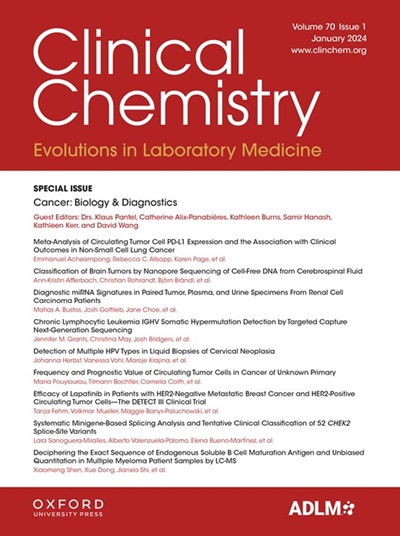微生物检测宏基因组cfDNA测序的综合评价。
IF 7.1
2区 医学
Q1 MEDICAL LABORATORY TECHNOLOGY
引用次数: 0
摘要
宏基因组无细胞DNA (cfDNA)测序为传染病的诊断提供了新的途径。由于血浆中微生物cfDNA的低浓度和高度碎片化性质,加上方法的复杂性,确保准确和可比的宏基因组cfDNA测序结果具有挑战性。本研究旨在评估不同实验室中宏基因组cfDNA测序检测血浆微生物的性能,并研究影响准确性的因素。方法设计了一个由18个微生物cfDNA群落组成的参考小组,并使用该参考小组在130个实验室中研究cfDNA宏基因组测序的性能。我们综合评估了准确度、重复性、抗干扰性、检出限(LoD)和线性相关性。结果大多数实验室的工作表现较好,F1平均得分为0.98。宏基因组cfDNA测序中的大多数污染来自“湿实验室”,68.25%(475/696)的假阳性序列与报告的微生物相匹配。元基因组cfDNA测序假阴性错误的主要原因是“干实验室”,占74.24%(49/66)。实验室显示良好的重现性、LoD和线性。人类cfDNA浓度升高的干扰很小,而基因相似的微生物的干扰更明显。总体而言,与细菌和真菌检测相比,病毒cfDNA检测表现出较弱的性能。结论本研究展示了cfDNA宏基因组测序在现实环境中的表现,确定了其开发和优化的关键因素。这些发现为传染病病原体的准确检测提供了有价值的指导,并促进了cfDNA宏基因组测序在诊断中的应用。本文章由计算机程序翻译,如有差异,请以英文原文为准。
A Comprehensive Assessment of Metagenomic cfDNA Sequencing for Microbe Detection.
BACKGROUND
Metagenomic cell-free DNA (cfDNA) sequencing provides a new avenue for diagnosing infectious diseases. Owing to the low concentration and highly fragmented nature of microbial cfDNA in plasma, coupled with methodological complexity, ensuring accurate and comparable metagenomic cfDNA sequencing results has proved challenging. This study aims to evaluate the performance of metagenomic cfDNA sequencing for detecting microorganisms in plasma across various laboratories and to examine factors affecting accuracy.
METHODS
A reference panel consisting of 18 microbial cfDNA communities was designed and used to investigate the performance of metagenomic cfDNA sequencing across 130 laboratories. We comprehensively assessed the accuracy, repeatability, anti-interference, limit of detection (LoD), and linear correlation.
RESULTS
The results showed that the performance of most laboratories was excellent, with an average F1 score of 0.98. Most contamination in metagenomic cfDNA sequencing originated from "wet labs," as 68.25% (475/696) of the false-positive sequences matched reported microorganisms. The chief cause (74.24%, 49/66) of false-negative errors in metagenomic cfDNA sequencing was from "dry labs." Laboratories showed favorable reproducibility, LoD, and linearity. Interference from elevated human cfDNA concentrations was minimal, whereas interference from genetically similar microorganisms was more pronounced. Overall, viral cfDNA detection showed weaker performance compared to bacterial and fungal detection.
CONCLUSIONS
This study presented the performance of metagenomic cfDNA sequencing in real-world settings, identifying key factors critical for its development and optimization. These findings provide valuable guidance for accurate pathogen detection in infectious diseases and promote the adoption of metagenomic cfDNA sequencing in diagnostics.
求助全文
通过发布文献求助,成功后即可免费获取论文全文。
去求助
来源期刊

Clinical chemistry
医学-医学实验技术
CiteScore
11.30
自引率
4.30%
发文量
212
审稿时长
1.7 months
期刊介绍:
Clinical Chemistry is a peer-reviewed scientific journal that is the premier publication for the science and practice of clinical laboratory medicine. It was established in 1955 and is associated with the Association for Diagnostics & Laboratory Medicine (ADLM).
The journal focuses on laboratory diagnosis and management of patients, and has expanded to include other clinical laboratory disciplines such as genomics, hematology, microbiology, and toxicology. It also publishes articles relevant to clinical specialties including cardiology, endocrinology, gastroenterology, genetics, immunology, infectious diseases, maternal-fetal medicine, neurology, nutrition, oncology, and pediatrics.
In addition to original research, editorials, and reviews, Clinical Chemistry features recurring sections such as clinical case studies, perspectives, podcasts, and Q&A articles. It has the highest impact factor among journals of clinical chemistry, laboratory medicine, pathology, analytical chemistry, transfusion medicine, and clinical microbiology.
The journal is indexed in databases such as MEDLINE and Web of Science.
 求助内容:
求助内容: 应助结果提醒方式:
应助结果提醒方式:


